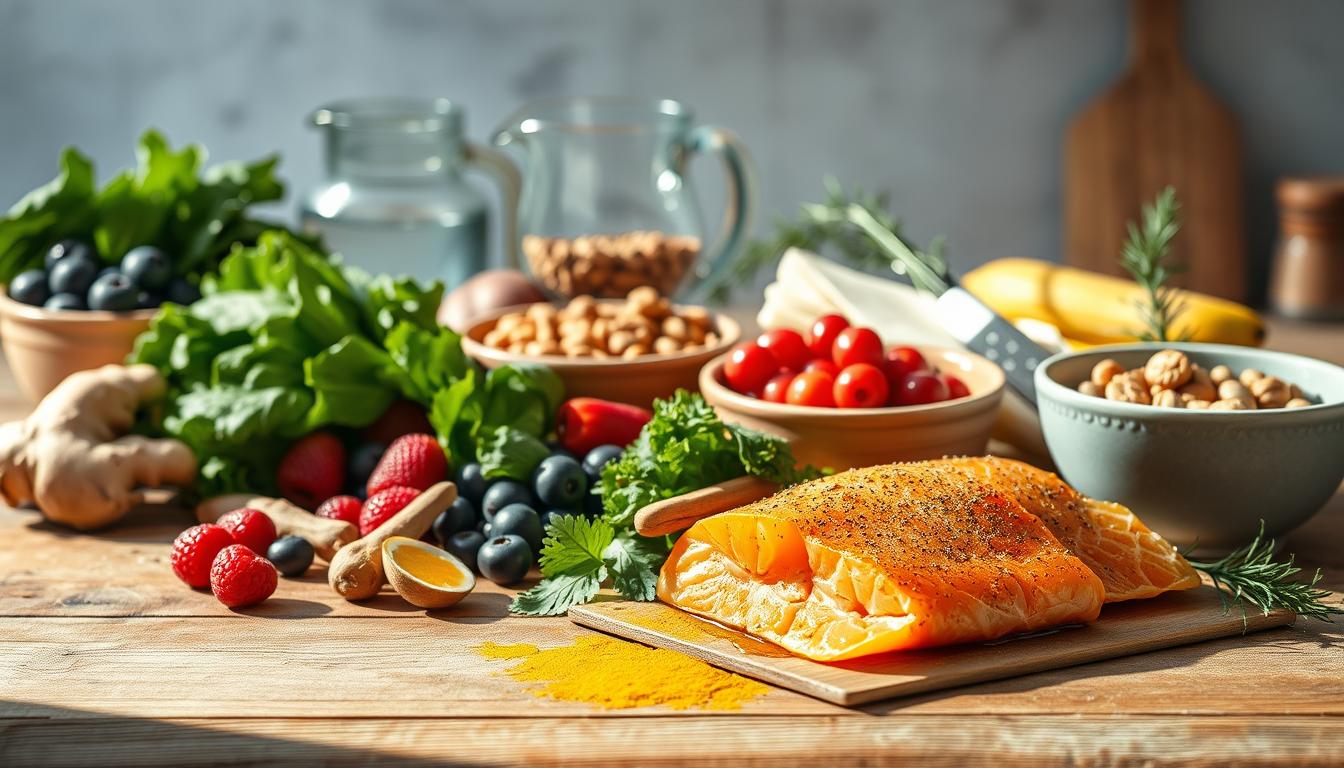Choosing the right foods is key to recovery. Foods like turmeric, walnuts, and spinach help reduce swelling and aid in tissue repair. They are especially helpful after injuries, surgeries, or chronic conditions.
Science proves that food can be as powerful as medicine. It turns our meals into tools for healing.
Knowing how these foods work is crucial for better recovery. This article will show you which foods fight inflammation and boost your immunity. It also explains how to build a diet that supports your body’s natural repair.
Readers will get practical tips backed by research. This will help you make informed choices for a faster recovery.
Key Takeaways
- Anti-inflammatory foods speed healing by lowering swelling.
- Nutrition choices directly impact how quickly the body recovers.
- Foods like berries, ginger, and fatty fish contain healing compounds.
- Chronic inflammation slows recovery; dietary changes can reverse this.
- Science confirms certain foods function as natural anti-inflammatory agents.
Understanding the Relationship Between Nutrition and Recovery
Your body fixes itself with the food you eat every day. Healing nutrition is more than just avoiding bad foods. It’s about giving your body what it needs to fix itself and fight off inflammation. Every meal gives your body the tools to mend muscles, tissues, and organs.
Why What You Eat Matters During Recovery
- Proteins rebuild muscle fibers after injury or illness
- Antioxidants neutralize free radicals that damage cells
- Vitamins C and D boost immune function during healing
The Impact of Poor Nutrition on Healing Time
“Poor dietary choices extend recovery timelines by 30-50% in clinical cases.” — Journal of Nutrition Science
A recovery diet without zinc or omega-3s slows down collagen making. Foods high in processed sugars raise inflammation, making healing slower. Not getting enough vitamin C can make wounds heal poorly.
How Nutrition Affects Repair Mechanisms
| Nutrient | Repair Role | Food Sources |
|---|---|---|
| Proteins | Builds new tissue structures | Salmon, eggs, lentils |
| Vitamin C | Collagen synthesis | Oranges, bell peppers |
| Zinc | Wound healing and immunity | Oysters, pumpkin seeds |
Every nutrient plays a role in fixing your body. Bad nutrition for recovery messes up these processes, slowing down healing. Eating right gives your body what it needs to fix itself faster.
What Is Inflammation and Why Should You Care?
Inflammation is your body’s natural defense against injury or infection. It starts by sending immune cells to fix damage. But if it doesn’t stop, it can slow down healing.
Think of it like a light. A quick flicker is normal. But constant flickering means something’s wrong.
Acute inflammation helps heal scrapes and viruses. But chronic inflammation lasts too long. It releases harmful molecules that damage tissues over time.
This can lead to problems like arthritis, heart disease, and slower healing after injuries or surgery.
Signs of chronic inflammation include constant fatigue, joint pain, and slow-healing wounds. Studies show it also raises health risk markers like C-reactive protein. The good news? nutrition for inflammation can help balance it out.
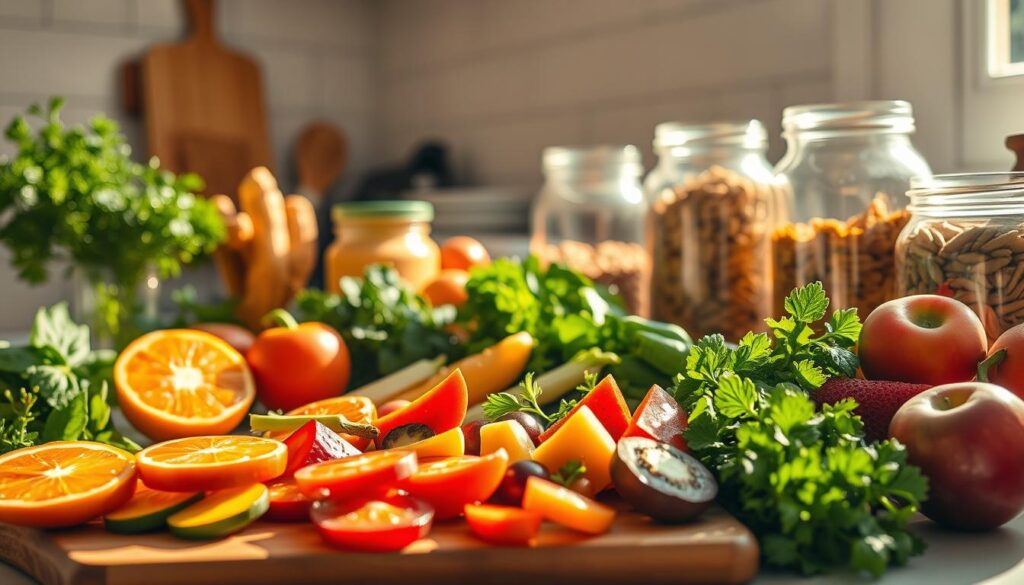
“Food choices can either fuel or calm inflammation, shaping how quickly your body recovers.”
A balanced anti-inflammatory diet focuses on whole foods. These foods reduce harmful cytokines and support healing. Leafy greens, fatty fish, and spices like turmeric are good examples.
By avoiding processed foods, you limit sugars and additives that trigger immune reactions.
Ignoring this balance can lead to longer recovery times. But by choosing the right foods, you can reduce inflammation naturally. This boosts your way to wellness.
The Science Behind Food-Based Anti-Inflammatory Effects
Anti-inflammatory foods work through precise biological processes. Let’s explore how these healing foods neutralize inflammation at a cellular level.
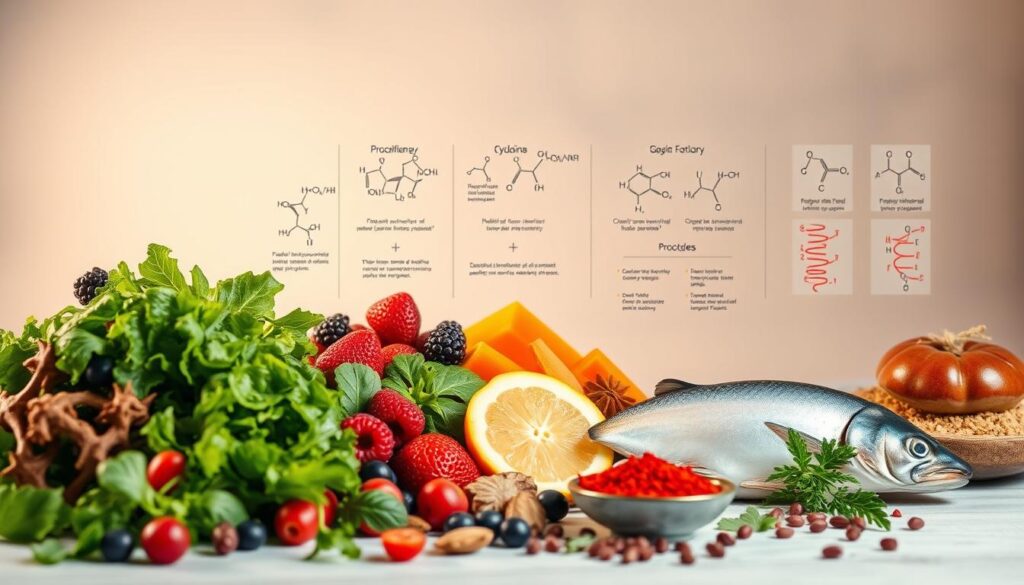
Antioxidants and Their Role in Reducing Inflammation
Antioxidants in nutrition for inflammation diets counteract free radicals, which trigger oxidative stress. Key players include:
- Vitamin C: Found in citrus, bell peppers, and broccoli.
- Vitamin E: Nuts and seeds protect cell membranes.
- Selenium: Brazil nuts and fish boost antioxidant enzymes.
- Carotenoids: Sweet potatoes and carrots neutralize damaging molecules.
Phytonutrients: Nature’s Recovery Compounds
Plants produce phytonutrients to defend against stress. These compounds activate anti-inflammatory pathways in humans. Examples:
| Phytonutrient | Source | Benefit |
|---|---|---|
| Quercetin | Apples, onions | Blocks inflammatory enzyme COX-2 |
| Resveratrol | Red grapes, dark chocolate | Activates longevity genes linked to reduced inflammation |
How Certain Foods Fight Inflammatory Processes
Some foods directly disrupt inflammation pathways. For instance:
- Omega-3 fatty acids in salmon inhibit pro-inflammatory cytokines.
- Curcumin in turmeric blocks NF-κB, a protein complex that triggers inflammation.
- Broccoli’s sulforaphane boosts antioxidant enzymes like glutathione.
“Foods aren’t just fuel—they’re molecular tools for healing,” says Dr. David Ludwig, nutrition researcher at Harvard T.H. Chan School of Public Health.
Understanding these mechanisms empowers you to choose anti-inflammatory foods that target inflammation at its source. Prioritizing these compounds accelerates recovery by addressing root causes rather than symptoms alone.
Nutrition for Recovery: Anti-inflammatory Foods That Heal
Research shows that certain anti-inflammatory foods can help heal faster and reduce pain. Studies confirm that foods rich in antioxidants and omega-3s support nutrition for recovery. They lower inflammation markers in the body.
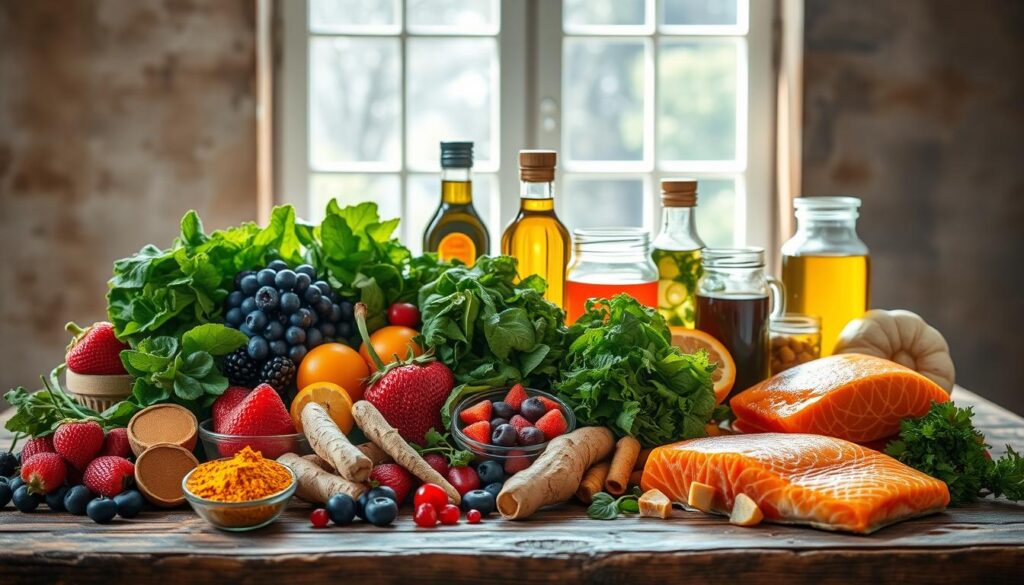
“Diets high in anti-inflammatory foods can cut healing time by up to 30% in musculoskeletal injuries,” reports a 2023 study in the Journal of Nutritional Science.
| Food | Key Benefits | Examples |
|---|---|---|
| Berries | Anthocyanins reduce joint inflammation | Blueberries, strawberries |
| Fatty Fish | Omega-3s combat muscle soreness | Salmon, mackerel |
| Olive Oil | Hydroxytyrosol fights gut inflammation | Extra-virgin varieties |
| Nuts | Alpha-linolenic acid (ALA) aids tissue repair | Walnuts, almonds |
| Leafy Greens | Vitamin K reduces bruising and swelling | Kale, spinach |
| Seeds | Lignans support immune recovery | Flaxseeds, chia seeds |
These foods are key for diets of professional athletes and post-surgery patients. Eating these foods that heal helps create a strong nutritional base. This base supports medical treatments. The next sections will show how to add these foods to your daily meals.
Top Anti-Inflammatory Food Categories for Faster Healing
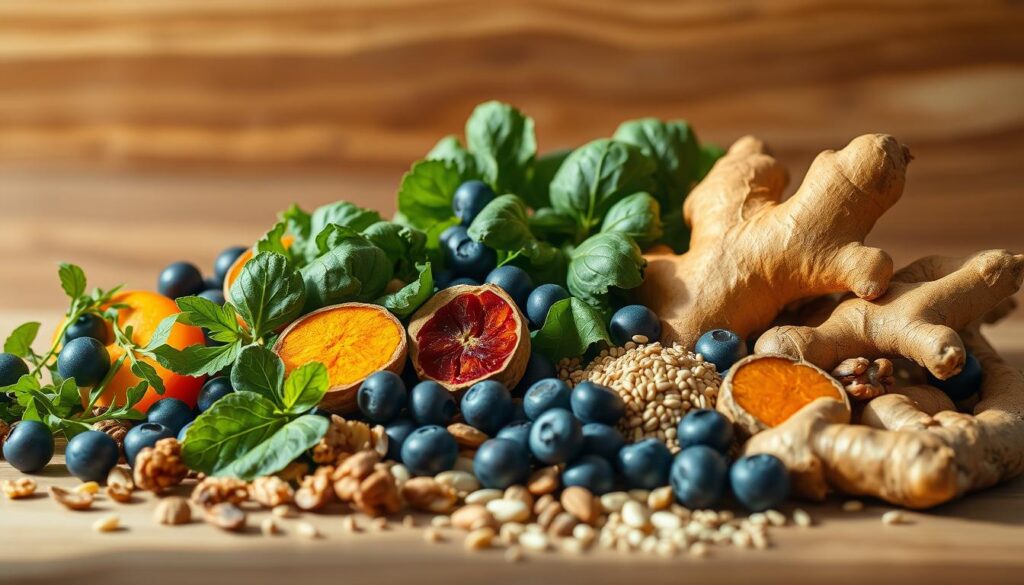
Nutrition is key to how fast your body heals. Certain foods help speed up recovery and lower inflammation. Make them a part of your daily diet for better results.
Colorful Fruits and Their Healing Properties
Colorful fruits are great for recovery. Their bright colors mean they’re full of antioxidants:
- Berries (blueberries, strawberries) have anthocyanins that help with joint pain and tissue damage.
- Citrus fruits like oranges and grapefruit are rich in vitamin C, important for collagen and wound healing.
- Pomegranates have ellagic acid, which fights swelling from injuries or surgery.
Eat 1-2 servings of these fruits daily. Try to eat them raw or lightly cooked to keep nutrients in.
Leafy Greens and Cruciferous Vegetables
Leafy greens like spinach, kale, and arugula are full of magnesium and vitamin K. Cruciferous veggies (broccoli, cauliflower) have glucosinolates that help detox. Aim for 2 cups a day:
- Kale is rich in kaempferol, an anti-inflammatory flavonoid.
- Broccoli sprouts have sulforaphane, which can help with arthritis symptoms.
- Swiss chard is high in betalains that ease muscle soreness.
Protein Sources That Support Tissue Repair
Proteins like salmon, lentils, and Greek yogurt give your body amino acids for tissue repair. Choose:
- Wild-caught salmon twice a week for omega-3s and anti-inflammatory DHA/EPA fatty acids.
- Plant-based proteins like chickpeas and quinoa for fiber and muscle-building amino acids.
- Lean turkey breast for zinc, a mineral important for immune function during healing.
Include 20-30g of protein at each meal to help with tissue repair. Pair it with veggies for even better results.
Healthy Fats: Essential Components of a Recovery Diet
Healthy fats are key for healing and a good recovery diet. Omega-3 fatty acids in foods like salmon, walnuts, and chia seeds help reduce inflammation. They also make cell membranes stronger, helping with tissue repair and nerve function.
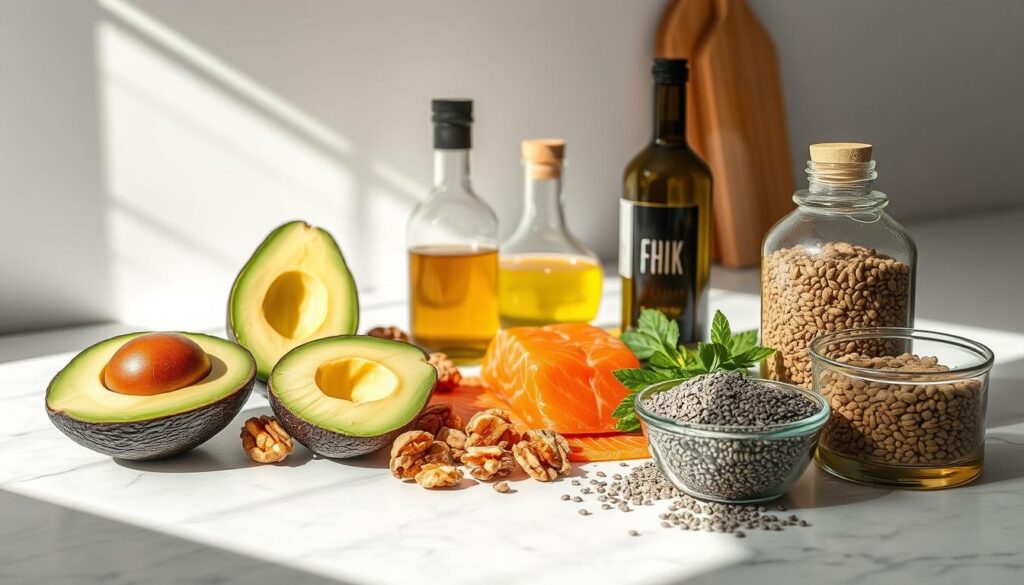
| Healthy Fats | Avoid These Fats |
|---|---|
| Omega-3s (salmon, flaxseeds) | Trans fats (fried foods, margarine) |
| Monounsaturated fats (avocado, olive oil) | Processed omega-6 oils (soybean oil) |
Choose baking or steaming to keep nutrients in your food. Aim for a 4:1 ratio of omega-6 to omega-3 fats for anti-inflammatory diets. For example, use olive oil instead of butter in dressings or add ground flaxseeds to smoothies.
- Include fatty fish twice weekly for omega-3 intake.
- Opt for nuts and seeds as snacks instead of chips.
- Use avocado or hummus as spreads instead of processed spreads.
Supplements like fish oil can help if you can’t get enough from food. Adding these fats to your diet speeds up healing by reducing joint pain and improving cell repair. Always choose whole foods for the best results.
Healing Herbs and Spices: Nature’s Medicine Cabinet
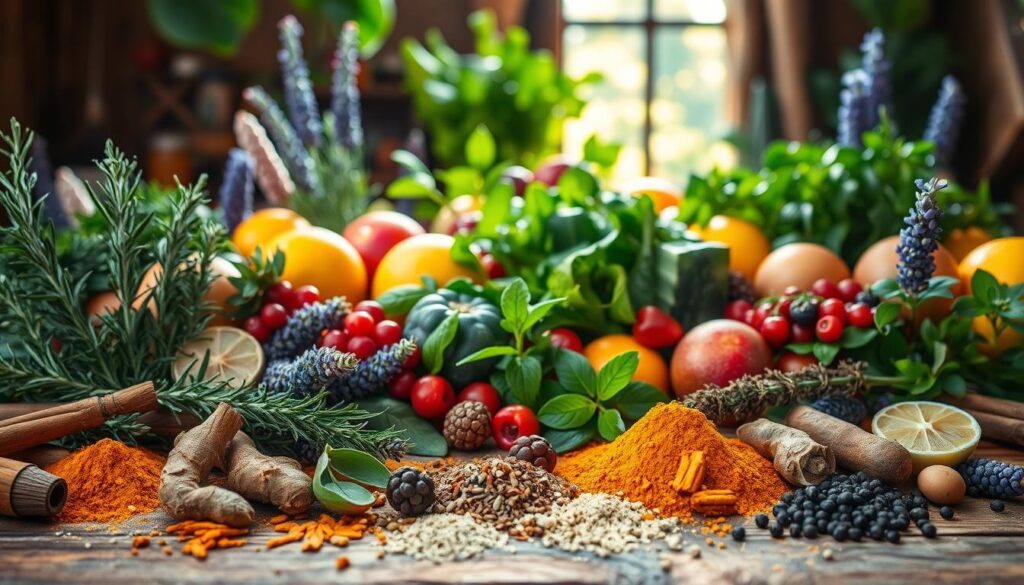
Herbs and spices do more than add flavor. They are powerful tools against inflammation. These everyday items contain compounds that help your body heal by reducing swelling and boosting recovery.
Tumeric and Ginger: Powerful Anti-Inflammatory Allies
Turmeric and ginger have compounds that block inflammation. This helps ease pain and swelling. To get the most benefits, add black pepper to turmeric.
A daily dose of 500–1000 mg of curcumin, with 1/4 tsp black pepper, boosts absorption. These spices are great for post-workout meals or managing joint pain.
Cinnamon, Garlic, and Other Healing Spices
Cinnamon and garlic fight inflammation and boost immunity. Rosemary and oregano help fight oxidative stress. Here’s a comparison of some key herbs:
| Herb/Spice | Active Compound | Key Benefits |
|---|---|---|
| Turmeric | Curcumin | Blocks COX-2 enzymes |
| Ginger | Gingerols | Reduces muscle inflammation |
| Cinnamon | Cinnamaldehyde | Regulates blood sugar and inflammation |
| Garlic | Allicin | Boosts immune response |
How to Incorporate More Healing Herbs Into Your Meals
- Mix turmeric into scrambled eggs or smoothies
- Add garlic to roasted vegetables or soups
- Season salads with cinnamon and rosemary
“Herbs like turmeric and ginger can rival pharmaceuticals in reducing inflammation,” notes a 2022 study in the Journal of Nutrition.
Make these foods a part of your daily routine to boost recovery. From golden milk to spice rubs, small changes can make a big difference.
Hydration and Recovery: Beyond Plain Water
Hydration is key for healing, but the right drinks can help more. Certain beverages are like liquid healing nutrition. They bring anti-inflammatory compounds and nutrients right to your cells.
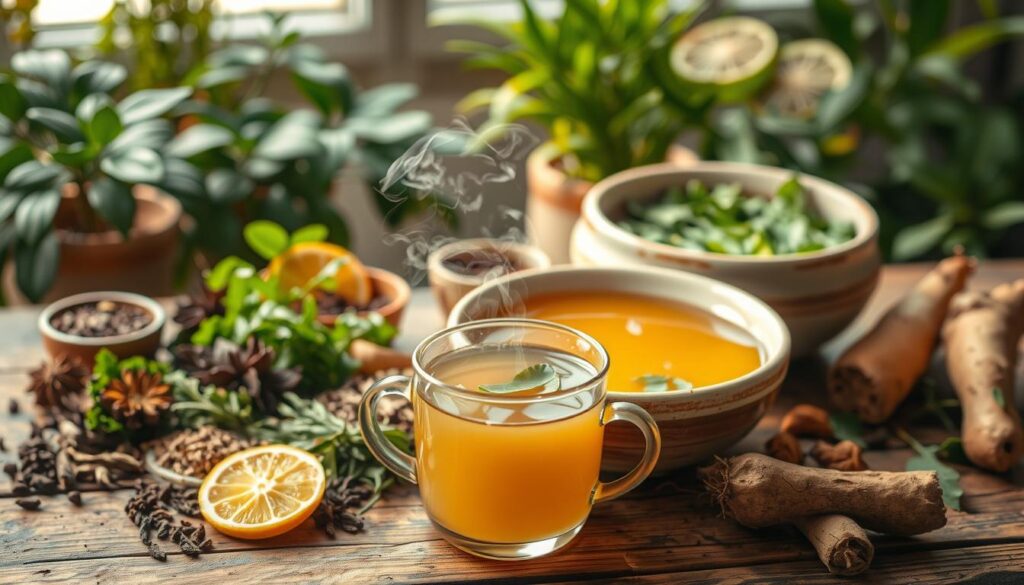
Anti-Inflammatory Teas and Infusions
Teas full of antioxidants and anti-inflammatory agents help fix tissues. Here are some good ones:
- Green tea: Catechins help reduce swelling; steep for 3-5 minutes for best results.
- Chamomile: Flavonoids calm digestive issues; great for a caffeine-free drink before meals.
- Tumeric-ginger blends: Curcumin and gingerols ease joint pain; add black pepper to increase absorption.
“A cup of turmeric tea or supplement daily can complement recovery foods by reducing systemic inflammation,” notes the Journal of Medicinal Food.
Healing Broths and Soups
Bone broths and vegetable soups carry nutrients like collagen, glycine, and zinc. These nutrition for recovery foods are essential:
- Bone broth: Simmer marrow bones 12–24 hours for gelatin, aiding gut and joint repair.
- Miso soup: Fermented soy boosts immunity; choose low-sodium versions.
- Vegetable consommé: Carrots, celery, and parsley provide vitamin C and potassium.
Drink broths with meals to boost amino acid intake. This speeds up cell repair.
Creating a Practical Anti-Inflammatory Meal Plan for Recovery
A registered dietitian says a good anti-inflammatory diet is more than picking foods. It’s about planning meals that match your energy and healing needs.
“Meal timing and nutrient balance are critical in a recovery diet,” says Dr. Emily Carter, a sports nutrition specialist. “Focus on meals that fuel without overwhelming the body.”
Here’s how to build a plan tailored to your recovery phase:
- Prioritize core staples: Base meals on omega-3-rich fish, leafy greens, and turmeric-spiced dishes. These foods form the foundation of a recovery-focused nutrition plan.
- Time meals strategically: Eat protein-rich meals within two hours of physical therapy sessions to support tissue repair.
- Simplify prep: Use batch cooking for soups and stews to ensure consistent nutrition for recovery without daily stress.
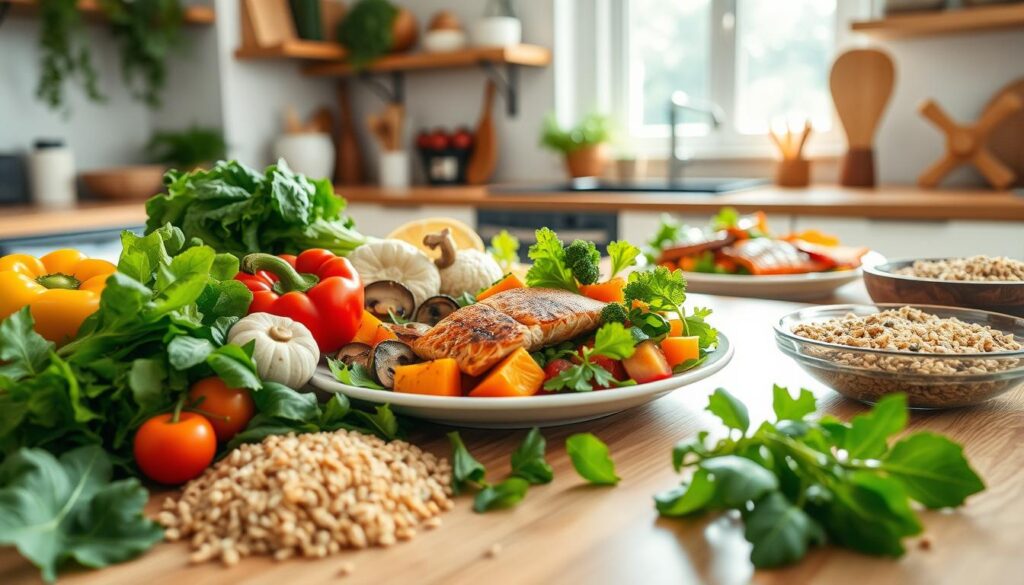
| Meal Type | Post-Surgery | Injury Recovery | Chronic Inflammation |
|---|---|---|---|
| Breakfast | Smoothie with spinach, ginger, and almond milk | Avocado toast with smoked salmon | Chia pudding with blueberries |
| Lunch | Quinoa salad with roasted veggies | Turkey and kale wrap with hummus | Lentil soup with cumin and paprika |
| Snack | Hard-boiled eggs with cherry tomatoes | Apple slices with almond butter | Green tea with dark chocolate nibs |
Adjust portions based on activity levels—higher protein intake on rehab days, lighter meals during rest phases. Always consult a healthcare provider before making major changes to your recovery diet.
Foods to Avoid During the Healing Process
Choosing the right recovery diet helps healing, but avoiding bad foods is key. Some foods can slow healing by causing inflammation and hurting tissue repair. Here’s what to cut down on:
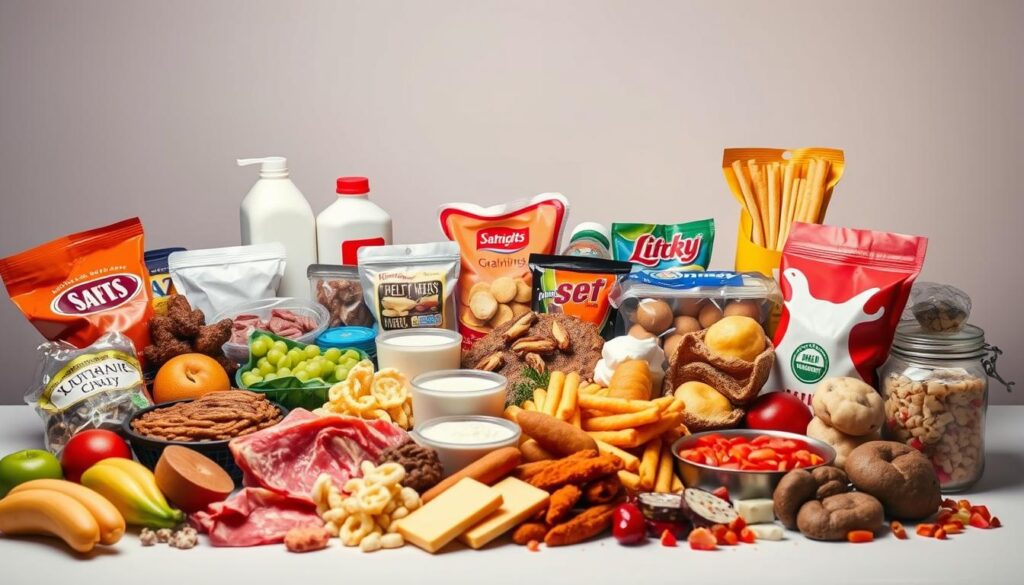
Inflammatory Foods That Slow Recovery
Here are the main offenders in your nutrition for inflammation journey:
- Refined sugars: Found in sodas, pastries, and candies—triggers insulin spikes and cytokine production.
- Processed oils: Soybean, corn, and canola oils high in omega-6 fatty acids promote chronic inflammation.
- Excess alcohol: Overconsumption disrupts gut health and liver function, hindering nutrient absorption.
- Artificial additives: MSG and nitrates in prepackaged meals can inflame joints and tissues.
| Avoid These | Choose Instead |
|---|---|
| White bread/pastries | Whole-wheat alternatives |
| Prepared snacks | Raw nuts/seeds |
| Store-bought salad dressings | Olive oil + vinegar blends |
Hidden Sources of Inflammation in Common Foods
Be careful of these sneaky culprits:
- Added sugars: Check labels for terms like “high-fructose corn syrup” even in yogurt or sauces.
- Conventional dairy: Casein proteins in some cheeses may irritate sensitive digestive systems.
- Gluten: Those with sensitivities should avoid wheat-based products entirely.
Reading labels carefully helps spot hidden offenders. Choose whole foods and certified gluten-free options when needed. Making small changes to your anti-inflammatory diet can greatly improve recovery.
Conclusion: Embracing Food as Medicine for Optimal Recovery
Healing nutrition is a daily habit, not a quick fix. Foods like berries, leafy greens, and fatty fish are packed with vitamins and antioxidants. They help reduce inflammation and speed up recovery.
When you combine these foods, they work even better together. Research shows that turmeric, broccoli, and olive oil can repair tissues and boost your immune system.
Making smart food choices is key to recovery. Stay away from processed snacks and sugary drinks. Instead, choose walnuts, green smoothies, or ginger tea.
Start with small changes, like adding spinach to eggs or flaxseeds to salads. These small steps can lead to big improvements in your health. Meal prepping and making gradual changes can make it easier.
Every meal is an opportunity to support your body’s healing. Include foods like avocados, beets, and dark chocolate in your diet. They help repair cells and keep you healthy.
Focus on eating whole foods instead of relying on supplements. Mix different spices, vegetables, and proteins to get a balanced diet. Small, consistent changes can lead to lasting health benefits.
Take charge of your recovery by choosing the right foods. Berries, leafy greens, and turmeric-rich dishes are more than just meals. They are tools that help your body heal. By eating these foods regularly, you can strengthen your body’s natural repair processes. Let nutrition be your ally in achieving optimal recovery.
See Healing anti-inflammatory supplementation
.
